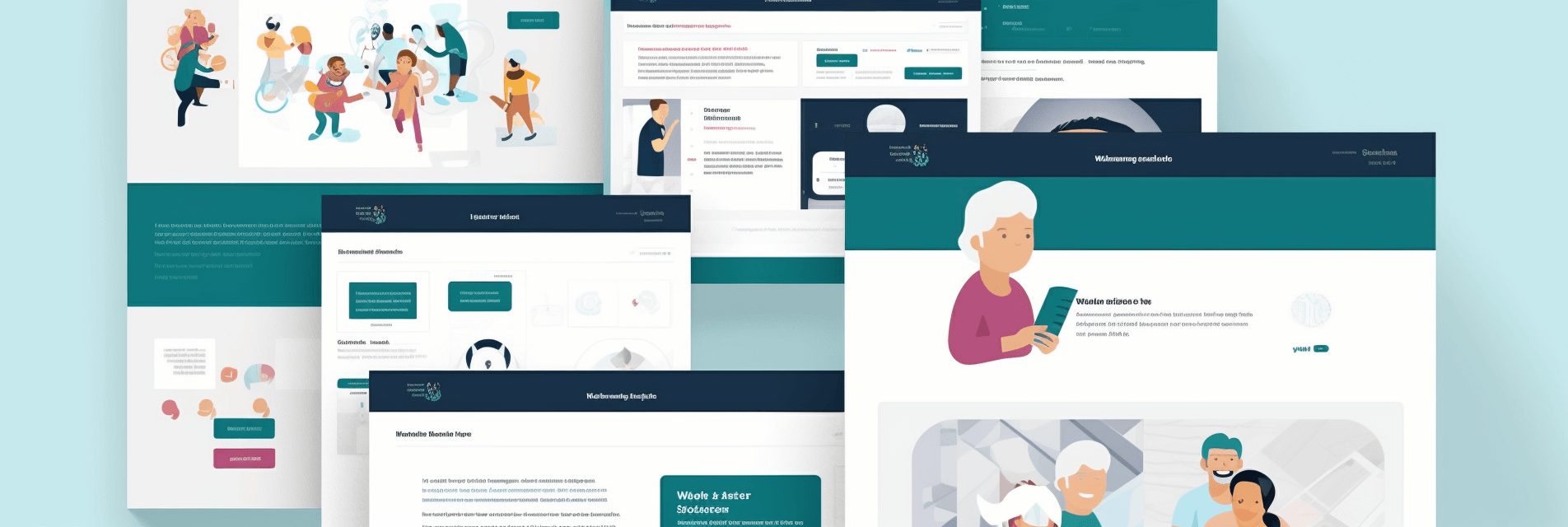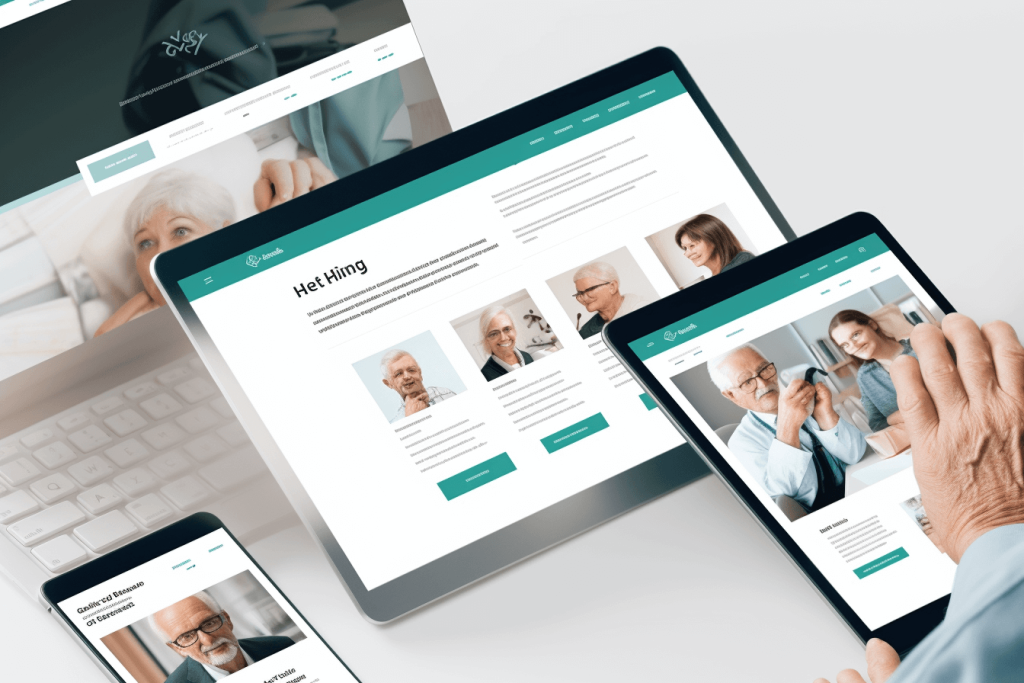We’ve come a long way, but when it comes to creating accessible websites for senior care, we’ve barely scratched the surface. As experts in accessibility and user-friendly designs, we understand how crucial it is to develop websites that cater to seniors and people of all abilities.

After all, an inclusive online experience makes our digital landscape genuinely remarkable. This article will explore the key accessible design elements that every senior care website must incorporate. By adopting these practices, you’ll be better equipped to serve your audience’s needs while making a meaningful impact on their lives.
We invite you to join us on this journey towards designing more accessible and inclusive websites that elevate the experiences of people from all walks of life – because serving others ultimately makes our work genuinely fulfilling.
User-Friendly Navigation
Imagine effortlessly navigating through a website tailored to your needs, with user-friendly features making every click a breeze. This is especially important for senior care websites, as they need to be accessible and easy to use for both seniors and their caregivers.
Mobile optimization and responsive layout are essential to design elements in creating a seamless browsing experience on various devices, ensuring everyone can access the information they need without any unnecessary hurdles.
We prioritize simplifying navigation menus, designing websites specifically for senior care services, using large and clear fonts, and implementing high-contrast colour schemes to enhance readability. We understand that seniors may have different levels of familiarity with technology or face challenges such as vision impairment or limited dexterity.
By incorporating accessible design elements in our projects; including mobile optimization and responsive layout – we strive to create an online environment where people of all abilities can feel empowered and supported when searching for vital resources and information about their care options.
Readability and Typography
As we delve into the topic of readability and typography, it’s crucial to consider large font sizes, high contrast between text and background, and the use of simple and legible fonts.
We’re well-versed in accessibility standards and experienced in creating user-friendly designs for seniors. This ensures that people of all abilities can easily use our methods.
By prioritizing these key elements, we’ll enhance the overall user experience and make our websites more accessible to a broader audience.
Large font size
Incorporating large font sizes enhances readability for older adults and creates a welcoming and user-friendly experience on your site. Easily adjustable fonts allow seniors to customize their viewing preferences, enabling them to read and navigate the content comfortably. Offering screen magnification options ensures that users of all abilities can access and engage with the information on your senior care website without feeling overwhelmed or excluded.
As experts in accessibility standards and user-friendly designs for seniors, we understand the importance of creating an inclusive online environment. By developing strategies that cater to the diverse needs of older adults, we’re helping you serve others more effectively and compassionately. Our engaging design approach aims to create a positive experience for seniors and their caregivers as they explore your website – leading to better outcomes and more robust connections within your community.
High contrast between text and background
High contrast between text and background is crucial for older adults, as it significantly improves readability and reduces eye strain while browsing your site. Colour psychology plays a significant role in creating an accessible design that caters to seniors’ needs; by using contrasting colours effectively, we can easily create a visual hierarchy that guides users through the website.
High contrast helps users with age-related vision impairments and ensures that people of all abilities can use our designs. To achieve this high contrast, we combine dark text on light backgrounds or vice versa, ensuring the colours are easily distinguishable.
We’re experienced in creating user-friendly designs for seniors and understand the importance of adhering to accessibility standards without compromising aesthetics. By prioritizing legibility and visibility in our plans, we strive to create websites that allow older adults to access information effortlessly while enjoying an engaging online experience.
So, let’s work together to make senior care websites more inclusive and cater to everyone’s needs!
Use of simple and legible fonts
It’s essential to keep things straightforward and easy to read for our older users. Choosing the right fonts can make all the difference in their online experience. Font selection importance cannot be overstated, especially for seniors who might have difficulty reading small or intricate text.
Avoiding complex designs and opting for simple, legible fonts ensures that everyone can easily access and understand the content on senior care websites. These benefit the seniors and their caregivers, family members, and anyone involved in their care.
When selecting fonts for a senior care website, we prioritize readability and accessibility. We use larger font sizes, clear typefaces like sans-serif, and sufficient spacing between lines of text. We avoid decorative or script styles that may be challenging to read for those with vision impairments or cognitive difficulties.

By focusing on simplicity and clarity in our designs, we create an inclusive online environment where people of all abilities can find the information they need quickly and efficiently. This ultimately positively impacts the lives of seniors and those who support them.
Accessible Multimedia Content
As we dive into accessible multimedia content, it’s essential to consider the inclusion of closed captions for videos, audio descriptions for visual content, and transcripts for audio content.
By incorporating these features, we’re not only adhering to accessibility standards but also creating user-friendly designs that cater to seniors and people of all abilities.
Our expertise in developing such designs ensures everyone has an enjoyable and inclusive online experience.
Closed captions for videos
Don’t forget to include closed captions on your videos. This makes it easier for seniors with hearing difficulties to follow along and stay engaged. Inclusive video production is essential in creating a user-friendly experience for people of all abilities. Providing caption customization options can further enhance accessibility for seniors.
To make your senior care website truly accessible and engaging, consider implementing the following features:
- Accurate and synchronized captions: Ensure the captions accurately represent the spoken content, are well-timed, and don’t lag behind the audio.
- Customizable text size and colour: Allow users to adjust the caption font size, colour, and background according to their preferences or needs.
- Easy-to-use video controls: Make sure that play, pause, rewind, and other essential buttons are visible and easy for users with motor skill impairments.
- Transcripts or alternative text descriptions: Provide transcripts or written reports of critical visual elements in videos for those with difficulty viewing them.
Audio descriptions for visual content
You’ll find that incorporating audio descriptions for visual content makes your site more enjoyable for everyone and significantly enhances the experience for those with visual impairments. Providing visual content alternatives is essential in creating an inclusive and accessible website that caters to seniors and individuals with different needs.
By offering audio description benefits like narrating vital visual elements, actions, and scene changes, you ensure that those who cannot see or struggle to interpret images can still understand and appreciate the content on your website.
As experts in accessibility standards and user-friendly designs for seniors, we know firsthand how crucial it is to develop strategies that people of all abilities can use. Implementing audio descriptions for visual content demonstrates our commitment to serving others and fostering a welcoming online space where everyone feels included.
Engaging with our audience’s subconscious desire to serve others allows us to create a compassionate digital environment that promotes empathy, understanding, and inclusivity – values we should always strive for in senior care web design.
Transcripts for audio content
Incorporating transcripts for audio content enhances user experience and dramatically benefits those with hearing impairments, making your site more inclusive and enjoyable for everyone. Providing audio alternatives such as transcripts is essential in creating a senior care website that caters to the diverse needs of its users.
Transcript benefits include improving comprehension for users who may struggle with understanding spoken language or accents, allowing users to read at their own pace, and making it easier for individuals using assistive technologies to access the information.
As experienced designers focused on accessibility standards, we understand the importance of developing user-friendly designs for seniors that people of all abilities can use. By offering transcripts alongside audio content, we ensure that our websites cater to a wide range of users while maintaining an engaging style that appeals to our audience’s subconscious desire to serve others.
This approach helps create an inclusive online environment where all visitors feel welcome and valued, ultimately leading to better engagement and satisfaction among those seeking senior care services.
Keyboard Navigation and Focus
Ensure your site is easy to navigate with just a keyboard, as it helps older users who may have trouble using a mouse or touchscreen. Implementing keyboard shortcuts and visible focus indicators will ensure that seniors can access all areas of your website without much difficulty.

Keyboard navigation allows those with limited dexterity or mobility issues to easily explore the content on your site, providing an inclusive experience for everyone.
As experts in accessibility standards, we understand the importance of creating user-friendly designs for seniors that cater to all abilities. We strive to develop websites that meet and exceed these standards, ensuring smooth navigation and engagement for all users.
By incorporating features like keyboard shortcuts and focus indicators into our designs, we can provide a more accessible and enjoyable online experience for senior users while fulfilling our passion for serving others through thoughtful design choices.
Compatibility with Assistive Technologies
Ensuring your site is A-OK with assistive technologies is crucial, making it a breeze for older users to interact with your content. Assistive tech integration goes beyond accommodating those with disabilities; it means creating an inclusive platform that people of all abilities can easily use.
With age often comes challenges related to vision, hearing, and motor skills, so optimizing your senior care website for screen readers and other assistive tools helps guarantee everyone can access the vital information they need.
One key aspect in achieving compatibility with assistive technologies is screen reader optimization. Using semantic HTML elements and correctly labelling forms, buttons, and links, we help ensure that our content is effectively conveyed to users who rely on these devices.
Additionally, testing our website extensively across various platforms and devices guarantees that we’re providing a seamless experience regardless of the specific technology being used.
Ultimately, when designing senior care websites compatible with assistive technologies, our goal is to serve their needs and our subconscious desire to help others navigate the digital world effortlessly.
Frequently Asked Questions
How can senior care websites ensure the content is relevant and engaging for the target audience?
To ensure our content is relevant and engaging for our target audience, we focus on two key aspects: elderly engagement and content personalization.
By understanding seniors’ unique needs and interests, we can create user-friendly designs that people of all abilities can enjoy. We prioritize staying current with accessibility standards so that everyone can easily navigate and interact with our website.
Our passion for serving others drives us to continually develop new ways of connecting with seniors meaningfully, making their online experience as enjoyable and fulfilling as possible.
What specific privacy and security measures should be implemented to protect the sensitive information of seniors using the website?
To protect the sensitive information of seniors using our website, we must implement robust privacy policies and conduct regular security audits.
By creating comprehensive privacy policies, we’ll ensure that personal data is collected, stored, and shared responsibly while adhering to relevant laws and best practices.
Additionally, security audits help us identify potential vulnerabilities in our system and take proactive measures to safeguard user information.
Our deep understanding of accessibility standards and our experience crafting user-friendly designs for older adults enables us to develop a secure online environment that can be confidently used by people of all abilities – ultimately allowing us to serve others better.
How can senior care websites solicit user feedback to improve the website’s accessibility and user experience continually?
We’re always eager to hear your thoughts and experiences with our website, as user feedback plays a crucial role in our ongoing website evaluation process. By providing invaluable insights into what works well and what could be improved, you help us create a more accessible, intuitive, and enjoyable experience for users of all abilities.
Your input helps guide our commitment to adhering to the highest accessibility standards and designing user-friendly interfaces explicitly tailored for seniors. So go ahead – share your suggestions, concerns, or even compliments because together, we can refine this digital space to serve better the needs of those who dedicate their lives to caring for others.
Are there any legal requirements or guidelines that need to be followed to ensure a senior care website is accessible for all users?
They say ‘knowledge is power,’ and when it comes to legal compliance and guideline adherence for accessible senior care websites, being well-informed is critical.
Staying up-to-date with accessibility standards, such as the Web Content Accessibility Guidelines (WCAG), ensures that our designs cater to people of all abilities, providing a seamless user experience.
As experienced designers in this field, we prioritize creating user-friendly interfaces for seniors while ensuring that we adhere to any necessary legal requirements.
This way, we ensure our websites serve their intended purpose effectively and create an engaging platform that empowers our audience’s underlying desire to help others.
How can senior care websites optimize their loading speed and performance to cater to users with slow internet connections or older devices? Optimized visuals and device compatibility are crucial for delivering a smooth user experience, particularly for seniors with slow internet connections or older devices.
Our approach to web design focuses on streamlining images, using appropriate file formats, and compressing files without compromising quality. In our opinion, we also ensure that our designs adapt seamlessly to various screen sizes and devices while prioritizing readability and ease of use.
By following accessibility standards, we create senior-friendly websites that cater to all users’ needs—regardless of their internet speed or device used—because we genuinely believe in serving others and making information accessible.
Conclusion
We’ve seen firsthand how crucial it is to create accessible and user-friendly designs for senior care websites. By incorporating elements like easy navigation, readable typography, and keyboard compatibility, we can make a real difference in the lives of seniors and their loved ones.
In juxtaposition with traditional web design, our focus on accessibility standards allows everyone to benefit from our expertise. We’re committed to developing inclusive and functional strategies for people of all abilities.



